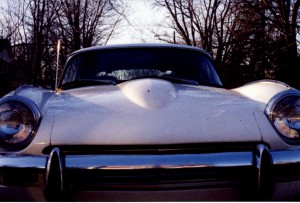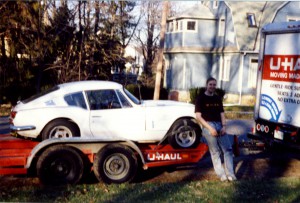A short while ago, I was traveling through New York, and somehow managed to leave my driver’s license with the TSA. This wouldn’t have been so bad, except that I needed to fly out of Chicago the next day, and I needed to rent a car at my final destination, which probably isn’t possible without an actual driver’s license.
My strategy was to go to the Secretary of State’s office downtown (this is the Illinois equivalent of the DMV) before it opened, in what seemed like a futile effort to acquire a license before I needed to be at the airport. Fifteen minutes before it opened, there was already a crowd of fifteen people waiting for the doors to open.
After a moment, a lady with a clipboard came out, carefully locking the door behind her. She announced that she would be coming to each of us in the order that we showed up, and giving us numbers to speed things along. She came to each of us and asked why we were there and confirm that we had the required documentation. Ahead of me in line:
- A man from Michigan wanting an Illinois driver’s license, who didn’t have his Michigan license because he lost it for driving under the influence. (Sent away)
- A woman who wanted a state ID, but didn’t have her Social Security card, because it “got wet.” (Sent away, with the suggestion that she replace that first.)
- A man in a suit with some kind of letter instead of one of the required documents. “They told me over the phone this would be sufficient,” he insisted. “Nobody told you that,” she said flatly, and sent him away.
- A teenager with no paperwork whatsoever, seeking a state ID. (Sent away.)
- A man seeking a driver’s license. After looking at his paperwork, she asked, “where do you live?” “Indiana,” he answered. She politely explained that you have to live in Illinois to get an Illinois driver’s license, and sent him away.
After a few variations on the above, she got to me last, and I showed her my paperwork, she handed me the number two. The doors opened, and $5 and 5 minutes later, I was holding a brand new driver’s license. I was utterly unprepared for this jaw-dropping display of government efficiency, which left me with plenty of time to catch my flight — time enough to go home first.
At home, the TSA from New York called, to let me know they had my driver’s license, which they offered to send me immediately. (Since I had to fly in a few hours, I would have needed a duplicate anyway, but I received my old license the next day.)
—
I contrast this sharply with my experience just a few years earlier at the same office of the same agency. I received in the mail a renewal notice for my license plates that had somebody else’s name on it. I tried calling first, and after an hour on hold, was informed that I’d have to go sort it out in person, and bring the physical license plates from my car.
After another hour and a half waiting in line, I explained the situation to the bored, slow-moving woman behind the counter who didn’t quite appear to be listening. “You want to change your name?”
I explained again that the name on my renewal notice was wrong, and handed her my license plates. She looked at the plates, at my renewal notice, and my driver’s license. After a few minutes of contemplation, she typed something into her computer.
“These aren’t your plates.”
Now we’re getting somewhere. “So, how do I get this corrected?”
“You have to bring in both sets of plates,” she explained.
“This is the only set I have. This is the set I was given… by you guys,” I tried to clarify further. “I only have one set.”
“Well, these are the ones you have to bring in,” she said, and gave me a plate number nothing like the ones I’d placed on the desk.
“So, you want me to find these license plates somewhere in the State of Illinois, detach them from whoever’s car they’re mounted on, and bring them in?”
“That’s right,” she beamed, apparently pleased that she had finally gotten through to me.
“So… Do you think the person whose name is on my renewal form has those plates?”
(blank stare)
“So… Can you tell me where you mailed the renewal notice for my plates?”
She looked this up on her computer, and compared it to the address on my driver’s license. “It doesn’t match your address here, so for security purposes, I can’t tell you what it is.”
“And this is the guy whose house you want me to drive to in order to retrieve the plates you sent him by mistake?”
(blank stare)
“Fine. I just want to renew these plates and correct my name.”
“You can’t do that, these aren’t your plates.”
It was my turn to stare blankly.
“You’ll get arrested if you put these on your car,” she explained slowly.
One of the two state troopers now standing immediately behind me said, “do we have a problem here?”
“If I didn’t have a problem, I don’t think I would’ve stood in line for so long,” I explained. “That’s kind of the whole point.”
Apparently deciding that I wasn’t a threat, they backed up … a little.
“Okay, look, I just want valid plates on my car that I can actually renew and that won’t get me arrested.”
She thought about this for a moment. “You can get new plates for $20 more.”
Unhappy, but with no alternatives, I handed over the money and she gave me a new set of plates.
“Just out of curiosity, are you going to tell the guy who has my plates? So he doesn’t accidentally renew them or whatever?”
“Oh, I’ve already updated the system,” she said languidly, “and there’s a warrant out for his arrest for the guy who stole your plates.”
“Wait… what? He didn’t steal my plates, you mailed them to him.”
“Yeah, but we don’t have a way to put that in the computer. I’m sure he can explain that when they pick him up.”
—
Epilogue: In an effort to spare some poor guy from being arrested for no particular reason, I called information and what little I knew and tried to call the guy whose name appeared on my renewal notice. The girl who answered the phone said he’d already sold the car “to some guy out of state.”




